Quantification of the Direct Solar Impact on Some Components of the Hydro-Climatic System
Abstract
:1. Introduction
2. Material and Methods
2.1. Data
2.1.1. Regional Scale
2.1.2. Large Scale
2.1.3. Solar Flux Index
2.2. Methods
2.2.1. Preliminaries
2.2.2. The information Theory Elements
2.2.3. Wavelet Coherence
3. Results
4. Conclusions and Further Work
Author Contributions
Funding
Conflicts of Interest
References
- Saltzman, B. A survey of statistical–dynamical models of the terrestrial climate. In Advances in Geophysics; Academic Press: New York, NY, USA; San Francisco, CA, USA; London, UK, 1978; Volume 20, pp. 183–304. [Google Scholar]
- Wen, G.; Cahalan, R.F.; Rind, D.; Jonas, J.; Pilewskie, P.; Dong, L.; Wu, D.L.; Krivova, N.A. Climate responses to SATIRE and SIM-based spectral solar forcing in a 3D atmosphere-ocean coupled GCM. Published by EDP Sciences. J. Space Weather Space Clim. 2017, 7, A11. [Google Scholar] [CrossRef] [Green Version]
- Zhang, G.; Su, X.; Singh, V.P.; Ayantobo, O.O. Modeling NDVI Using Joint Entropy Method Considering Hydro-Meteorological Driving Factors in the Middle Reaches of Hei River Basin. Entropy 2017, 19, 502. [Google Scholar] [CrossRef] [Green Version]
- Smith, R. A Mutual Information Approach to Calculating Nonlinearity. Stat 2015, 4, 291–303. [Google Scholar] [CrossRef] [Green Version]
- Goodwell, A.; Jiang, P.; Ruddell, B.; Kumar, P. Debates -Does Information Theory provide a new paradigm for Earth science? Identifying causality, interaction, and feedback. WRR 2020, 56. [Google Scholar] [CrossRef] [Green Version]
- Seth, A.K. A MATLAB toolbox for Granger causal connectivity analysis. J. Neurosci. Methods 2010, 186, 262–273. [Google Scholar] [CrossRef]
- Barnett, L.; Seth, A.K. Behaviour of Granger causality under _ltering: Theoretical invariance and practical application. J. Neurosci. Methods 2011, 201, 404–419. [Google Scholar] [CrossRef]
- Bressler, S.L.; Seth, A.K. Wiener-Granger causality: A well established methodology. NeuroImage 2011, 58, 323–329. [Google Scholar] [CrossRef] [PubMed]
- Aghakouchak, A. Entropy–copula in hydrology and climatology. J. Hydromet. 2014, 15, 2176–2189. [Google Scholar] [CrossRef]
- Guiasu, S.; Reischer, C. The relative information generating function. Inf. Sci. 1985, 35, 235–241. [Google Scholar] [CrossRef]
- Hao, Z.; Singh, V.P. Entropy-copula method for single-site monthly streamflow simulation. Water Resour. Res. 2012, 48, W06604. [Google Scholar] [CrossRef]
- Manshour, P.; Balasis, G.; Consolini, G.; Papadimitriou, C.; Paluš, M. Causality and Information Transfer Between the SolarWind and the Magnetosphere–Ionosphere System. Entropy 2021, 23, 390. [Google Scholar] [CrossRef] [PubMed]
- Stumpo, M.; Consolini, G.; Alberti, T.; Quattrociocchi, V. Measuring Information Coupling between the Solar Wind and the Magnetosphere–Ionosphere System. Entropy 2020, 22, 276. [Google Scholar] [CrossRef] [Green Version]
- Pothapakula, P.K.; Primo, C.; Ahrens, B. Quantification of Information Exchange in Idealized and Climate System Applications. Entropy 2019, 21, 1094. [Google Scholar] [CrossRef] [Green Version]
- James, R.G.; Barnett, N.; Crutchfield, J.P. Information Flows? A Critique of Transfer Entropies. Phys. Rev. Lett. 2016, 116, 238701. [Google Scholar] [CrossRef]
- Hunt, B.G. Nonlinear Influences-A Kay to Short-Term Climatic Perturbations. J. Atmos. Sci. 1988, 45, 387–395. [Google Scholar] [CrossRef] [Green Version]
- Lorenz, E.N. Nondeterministic Theories of Climatic Change. Quart. Res. 1976, 6, 495–506. [Google Scholar] [CrossRef]
- Ghil, M. A century of nonlinearity in the geosciences. Earth Space Sci. 2019, 6, 1007–1042. [Google Scholar] [CrossRef] [Green Version]
- Haigh, J.D.; Winning, A.R.; Toumi, R.; Harder, J.W. An influence of solar spectral variations on radiative forcing of climate. Nature 2010, 467, 696–699. [Google Scholar] [CrossRef] [PubMed] [Green Version]
- Haigh, J. Solar influences on climate. In Grantham Institute for Climate Change, Briefing Paper No. 5; Imperial College London: London, UK, 2011. [Google Scholar]
- Hsieh, W.W.; Tang, B. Applying neural network models to prediction and data analysis in meteorology and oceanography. Bull. Amer. Meteor. Soc. 1998, 79, 1855–1870. [Google Scholar] [CrossRef]
- Hsieh, W.W. Nonlinear multivariate and time series analysis by neural network methods. Rev. Geophys. 2004, 42, RG1003. [Google Scholar] [CrossRef] [Green Version]
- Siggiridou, E.; Koutlis, C.; Tsimpiris, A.; Kugiumtzis, D. Evaluation of Granger Causality Measures for Constructing Networks from Multivariate Time Series. Entropy 2019, 21, 1080. [Google Scholar] [CrossRef] [Green Version]
- Guiasu, S. Information Theory with Applications; McGraw-Hill Inc.: London, UK, 1977. [Google Scholar]
- Runge, J.; Nowack, P.; Kretschmer, M.; Flaxman, S.; Sejdinovic, D. Detecting and quantifying causal associations in large nonlinear time series datasets. Sci. Adv. 2019, 5, eaau4996. [Google Scholar] [CrossRef] [PubMed] [Green Version]
- Schreiber, T. Measuring Information Transfer. Phys. Rev. Let. 2000, 85, 461–464. [Google Scholar] [CrossRef] [PubMed] [Green Version]
- Palus, M.; Vejmelka, M. Directionality from coupling between bivariate time series: How to avoid false causalities and missed connections. Phys. Rev. 2007, 75, 056211. [Google Scholar]
- Goodwell, A.; Kumar, P. Information theoretic measures to infer feedback dynamics in coupled logistic networks. Entropy 2015, 17, 7468–7492. [Google Scholar] [CrossRef] [Green Version]
- Mares, I.; Mares, C.; Dobrica, V.; Demetrescu, C. Applications of the information entropy to quantify non-linear relationship between the precipitation in the Danube basin and the climate indices. In Proceedings of the EGU General Assembly Conference Abstracts, Vienna, Austria, 7–12 April 2019; Volume 21, p. 7115. [Google Scholar]
- Grinsted, A.; Moore, J.C.; Jevrejeva, S. Application of the cross wavelet transform and wavelet coherence to geophysical time series. Nonlinear Process. Geophys. 2004, 11, 561–566. [Google Scholar] [CrossRef]
- Le Mouël, J.L.; Lopes, F.; Courtillot, V. A solar signature in many climate indices. J. Geophys. Res. Atmospheres. 2019, 124, 2600–2619. [Google Scholar] [CrossRef]
- Kumar, P.; Gupta, H.V. Debates—Does Information Theory Provide a New Paradigm for Earth Science? Wat. Resour. Res. 2020, 56, e2019WR026398. [Google Scholar] [CrossRef] [Green Version]
- Mares, I.; Mares, C.; Dobrica, V.; Demetrescu, C. Comparative study of statistical methods to identify a predictor for discharge at Orsova in the Lower Danube Basin. Hydrol. Sci. J. 2020, 65, 371–386. [Google Scholar] [CrossRef]
- Peixoto, J.P.; Oort, A.H. Physics of Climate; American Institute of Physics: College Park, MD, USA, 1992; 520p. [Google Scholar]
- Ramos, A.M.T.; Macau, E.E.N. Minimum Sample Size for Reliable Causal Inference Using Transfer Entropy. Entropy 2017, 19, 150. [Google Scholar] [CrossRef] [Green Version]
- Mares, I.; Mares, C.; Mihailescu, M. Stochastic modeling of theconnection between sea level pressure and discharge in the Danube lower basin by means of Hidden Markov Model. In Proceedings of the EGU General Assembly Conference Abstracts, Vienna, Austria, 7–12 April 2013; Volume 15, p. 7606. [Google Scholar]
- Barriopedro, D.; García-Herrera, R.; Huth, R. Solar modulation of Northern Hemisphere winter blocking. J. Geophys. Res. 2008, 113, D14118. [Google Scholar] [CrossRef] [Green Version]
- McCormac, B.M.; Seliga, T.A. Solar-Terrestrial influences on weather and climate. In Proceedings of the Symposium/Workshop Held at the Fawcett Center for Tomorrow, The Ohio State University, Columbus, OH, USA, 24–28 August 1978. [Google Scholar]
- Gray, L.J.; Ball, W.; Misios, S. Solar influences on climate over the Atlantic/European sector. In Proceedings of the AIP Conference Proceedings 1810, Auckland, New Zealand, 16–22 April 2017; p. 020002. [Google Scholar]
- Tapping, K.F. The 10.7 cm solar radio flux (F10. 7). Space Weather 2013, 11, 394–406. [Google Scholar] [CrossRef]
- Bednarz, E.M.; Maycock, A.C.; Telford, P.J.; Braesicke, P.; Abraham, N.L.; Pyle, J.A. Simulating the atmospheric response to the 11-year solar cycle forcing with the UM-UKCA model: The role of detection method and natural variability. Atmos. Chem. Phys. 2019, 19, 5209–5233. [Google Scholar] [CrossRef] [Green Version]
- Gossard, E.E.; Hooke, W.H. Waves in the Atmosphere; Elsevier: Amsterdam, The Netherlands; New York, NY, USA, 1975; p. 456. [Google Scholar]
- Kuroda, Y.; Kodera, K. Effect of solar activity on the Polar-night jet oscillation in the northern and southern hemisphere winter. J. Met. Soc. Jpn. 2002, 80, 973–984. [Google Scholar] [CrossRef] [Green Version]
- Kuroda, Y. On the origin of the solar cycle modulation of the Southern Annular Mode. J. Geophys. Res. Atmospheres. 2018, 123, 1959–1969. [Google Scholar] [CrossRef]
- Scholz, M.; Kaplan, F.; Guy, C.L.; Kopka, J.; Selbig, J. Non-linear PCA: A missing data approach. Bioinformatics 2005, 21, 3887–3895. [Google Scholar] [CrossRef] [Green Version]
- Roy, I.; Haigh, J.D. Solar cycle signals in sea level pressure and sea surface temperature. Atmos. Chem. Phys. 2010, 100, 3147–3153. [Google Scholar] [CrossRef] [Green Version]
- Granger, C.W.J. Econometrica. J. Econom. Soc. 1969, 37, 424. [Google Scholar] [CrossRef]
- Shannon, C.E. A mathematical theory of communication. Bell System Technical J. 1948, 27, 379–423. [Google Scholar] [CrossRef] [Green Version]
- Bennett, A.; Nijssen, B.; Ou, G.; Clark, M.; Nearing, G. Quantifying process connectivity with transfer entropy in hydrologic models. Wat. Resour. Res. 2019, 55, 4613–4629. [Google Scholar] [CrossRef]
- Ruddell, B.L.; Kumar, P. Ecohydrologic process networks: 1. Identification. Wat. Resour. Res. 2009, 45. [Google Scholar] [CrossRef]
- Hlinka, J.; Hartman, D.; Vejmelka, M.; Runge, J.; Marwan, N.; Kurths, J.; Palus, M. Reliability of Inference of Directed Climate Networks Using Conditional Mutual Information. Entropy 2013, 15, 2023–2045. [Google Scholar] [CrossRef]
- Timme, N.M.; Lapish, C. A Tutorial for Information Theory in Neuroscience. eNeuro 2018, 5, 0052-18. [Google Scholar] [CrossRef]
- Pearl, J. Probabilistic Reasoning in Intelligent Systems: Networks of Plausible Inference; Elsevier: Amsterdam, The Netherlands, 2014. [Google Scholar]
- Timme, N.; Ito, S.; Myroshnychenko, M.; Yeh, F.C.; Hiolski, E.; Hottowy, P.; Beggs, J.M. Multiplex networks of cortical and hippocampal neurons revealed at different timescales. PLoS ONE 2014, 9, e115764. [Google Scholar] [CrossRef]
- Diks, C.; Fang, H. A Consistent Nonparametric Test for Granger Non-Causality Based on the Transfer Entropy. Entropy 2020, 22, 1123. [Google Scholar] [CrossRef] [PubMed]
- Pethel, S.D.; Hahs, D.W. Exact test of independence using mutual information. Entropy 2014, 16, 2839–2849. [Google Scholar] [CrossRef] [Green Version]
- Steuer, R.; Kurths, J.; Daub, C.O.; Weise, J.; Selbig, J. The mutual information: Detecting and evaluating dependencies between variables. Bioinformatics 2002, 18 (Suppl. 2), S231–S240. [Google Scholar] [CrossRef] [Green Version]
- Theiler, J.; Eubank, S.; Longtin, A.; Galdrikian, B.; Farmer, J.D. Testing for nonlinearity in time series: The method of surrogate data. Phys. D Nonlinear Phenom. 1992, 58, 77–94. [Google Scholar] [CrossRef] [Green Version]
- Boba, P.; Bollmann, D.; Schoepe, D.; Wester, N. Efficient computation and statistical assessment of transfer entropy. Front. Phys. 2015, 3, 267–278. [Google Scholar] [CrossRef]
- Timmermann, A.; Voss, H.U.; Pasmanter, R. Empirical dynamical system modeling of ENSO using nonlinear inverse techniques. J. Phys. Oceanogr. 2001, 31, 1579–1598. [Google Scholar] [CrossRef]
- Lizier, J.T.; Bertschinger, N.; Jost, J.; Wibral, M. Information Decomposition of Target Effects from Multi-Source Interactions: Perspectives on Previous, Current and Future Work. Entropy 2018, 20, 307. [Google Scholar] [CrossRef] [PubMed] [Green Version]
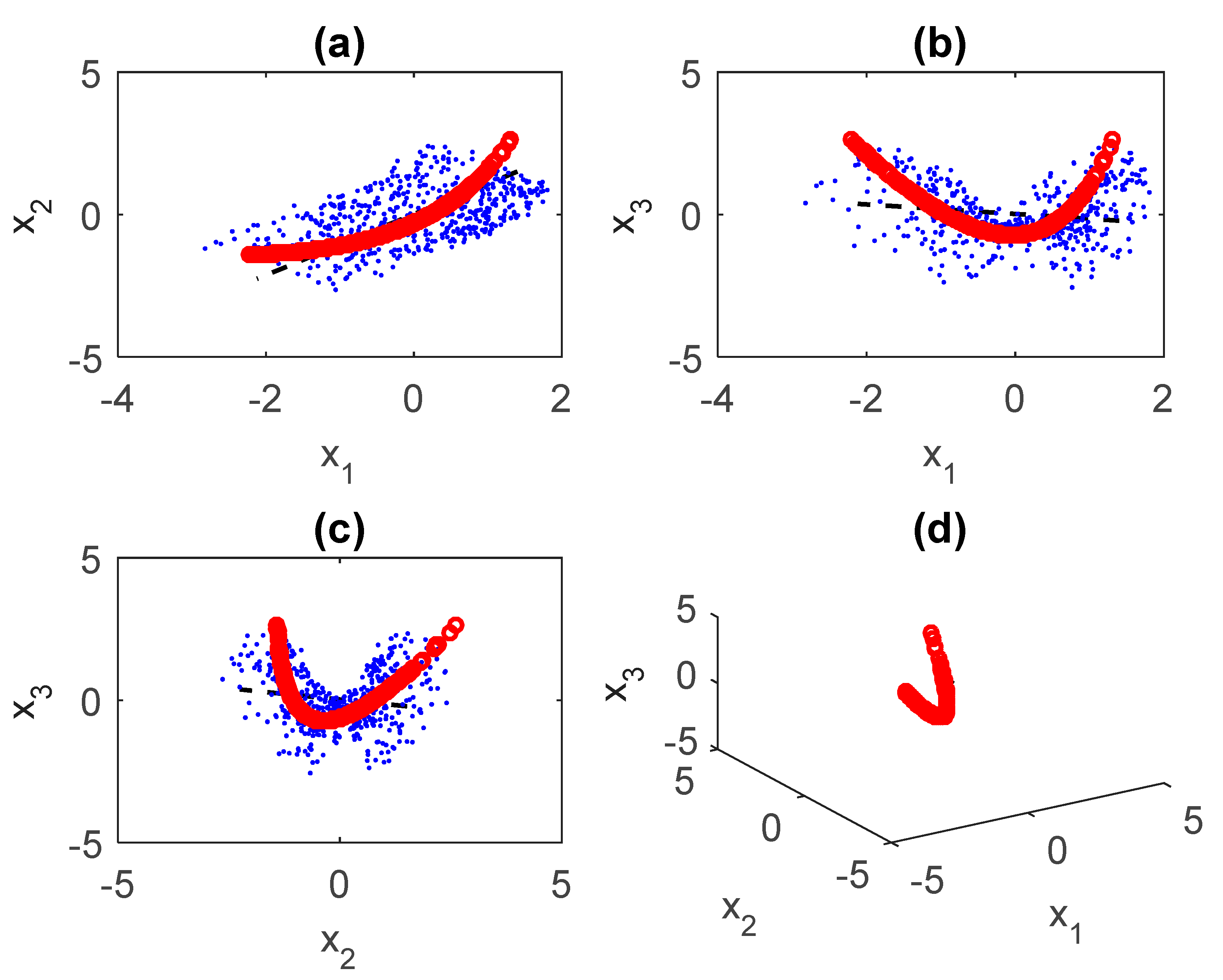
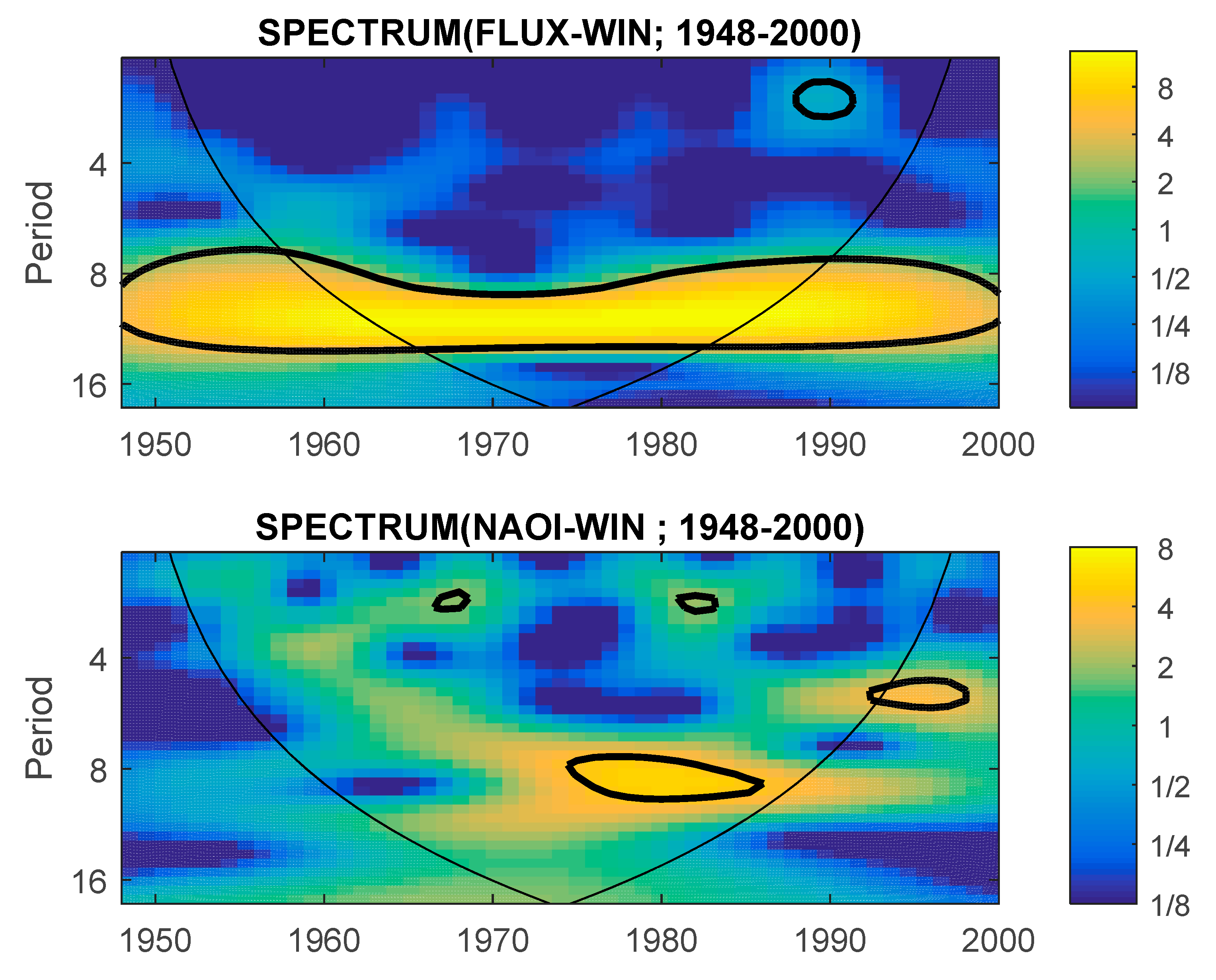
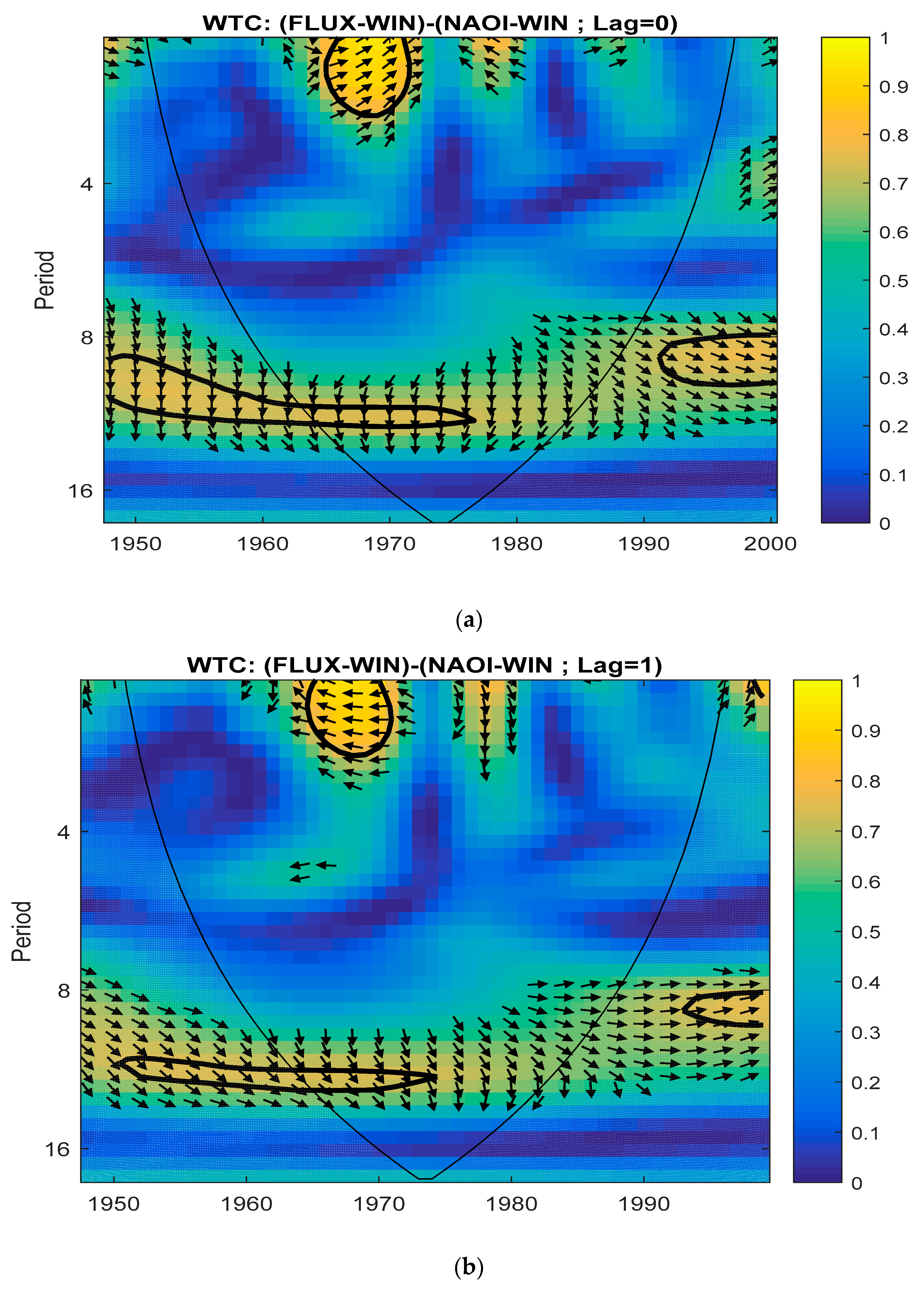
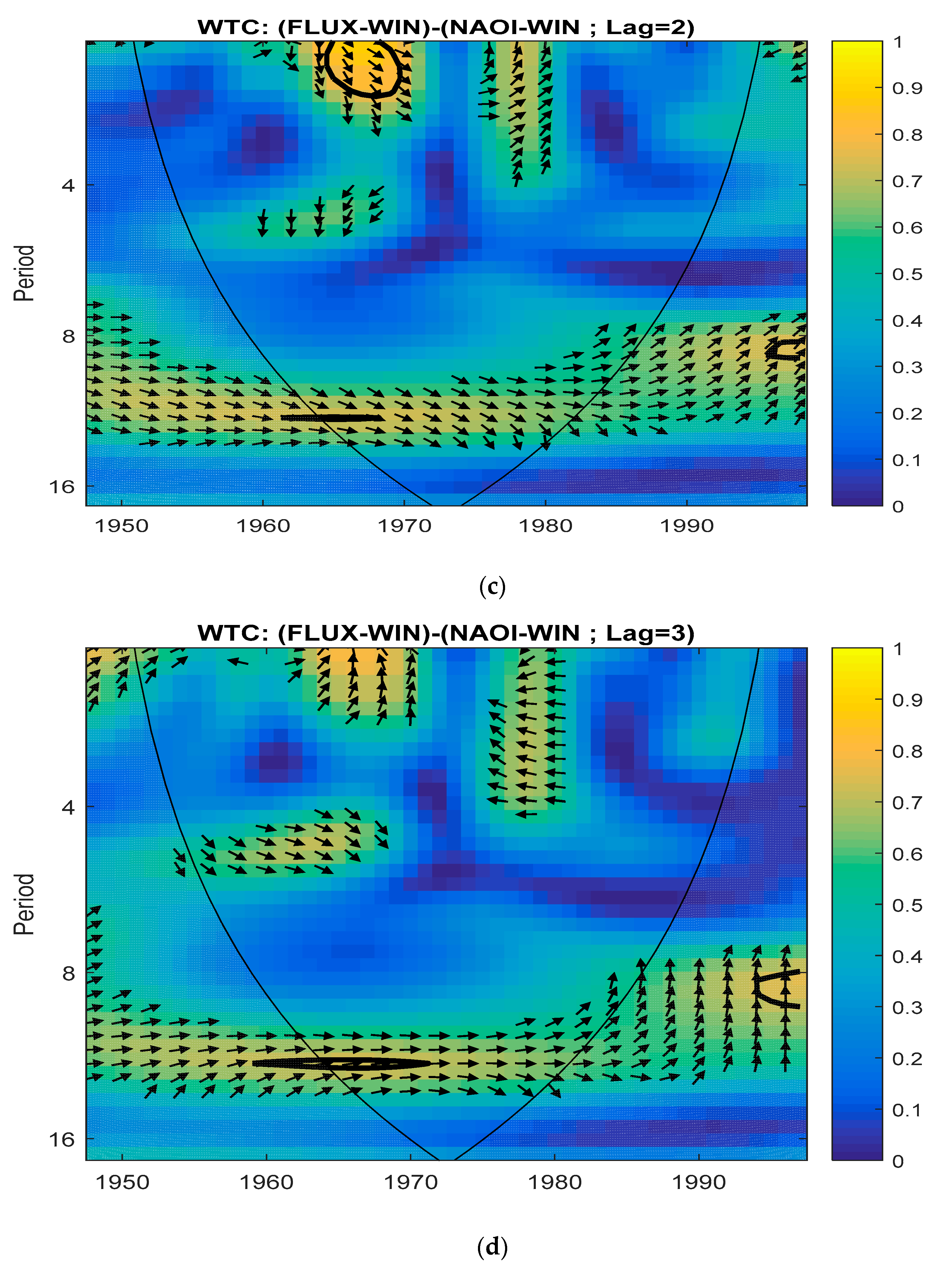
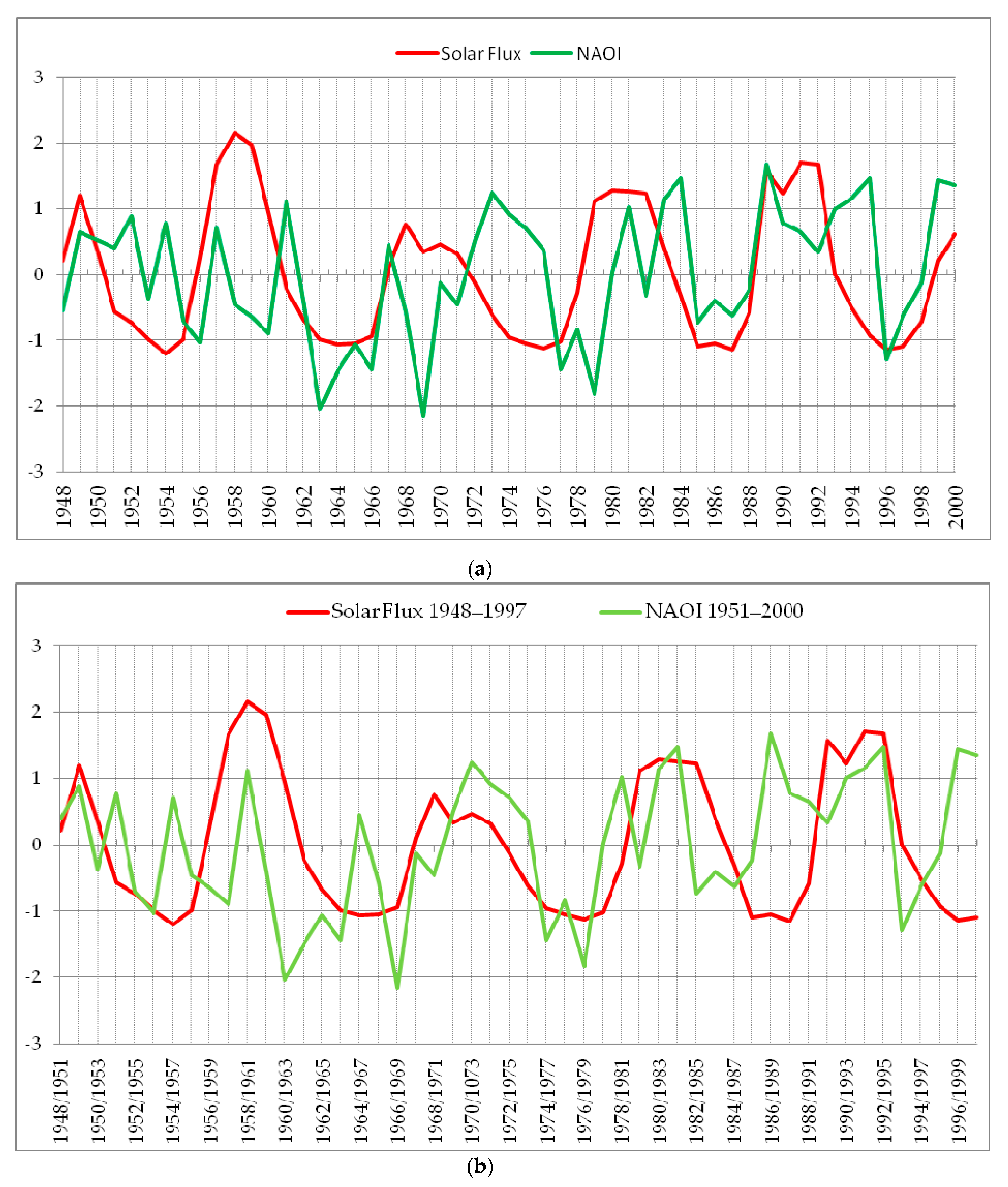
| Solar Flux (Source) | ||||||||
|---|---|---|---|---|---|---|---|---|
| Spring | Summer | Fall | Winter | |||||
| Terrestrial variable (Target) | TE | Lag | TE | Lag | TE | Lag | TE | Lag |
| GBOI | – | – | 0.249 (0.61) | 1 | 0.316 (0.37) | 4 | 0.425 (0.03) | 4 |
| NAOI | 0.258 (0.66) | 4 | 0.287 (0.37) | 2 | 0.270 (0.58) | 5 | 0.376 (0.12) | 5 |
| ABI | 0.409 (0.02) | 4 | – | – | – | – | 0.079 (1.00) | 5 |
| AEBI | 0.486 (0.001) | 1 | 0.392 (0.03) | 4 | 0.277 (0.56) | 4 | 0.344 (0.05) | 3 |
| EBI | – | – | 0.058 (0.50) | 1 | 0.332 (0.05) | 3 | 0.090 (0.63) | 5 |
| TPPI | 0.310 (0.06) | 2 | 0.228 (0.63) | 3 | 0.158 (0.5) | 5 | – | – |
| Q_ORS | 0.367 (0.15) | 3 | 0.314 (0.25) | 3 | 0.337 (0.15) | 2 | 0.248 (0.67) | 1 |
Publisher’s Note: MDPI stays neutral with regard to jurisdictional claims in published maps and institutional affiliations. |
© 2021 by the authors. Licensee MDPI, Basel, Switzerland. This article is an open access article distributed under the terms and conditions of the Creative Commons Attribution (CC BY) license (https://creativecommons.org/licenses/by/4.0/).
Share and Cite
Mares, C.; Mares, I.; Dobrica, V.; Demetrescu, C. Quantification of the Direct Solar Impact on Some Components of the Hydro-Climatic System. Entropy 2021, 23, 691. https://doi.org/10.3390/e23060691
Mares C, Mares I, Dobrica V, Demetrescu C. Quantification of the Direct Solar Impact on Some Components of the Hydro-Climatic System. Entropy. 2021; 23(6):691. https://doi.org/10.3390/e23060691
Chicago/Turabian StyleMares, Constantin, Ileana Mares, Venera Dobrica, and Crisan Demetrescu. 2021. "Quantification of the Direct Solar Impact on Some Components of the Hydro-Climatic System" Entropy 23, no. 6: 691. https://doi.org/10.3390/e23060691






